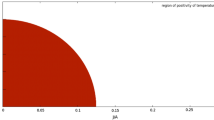Abstract
By pointing out an error in the previous derivation of the area spectrum based on Ashtekar’s variables, we suggest a new area spectrum; instead of the norm of Ashtekar’s gravitational electric field, we show that the norm of our “new” gravitational electric field based on our “newer” variables, which we construct in this paper for this purpose, gives the correct area spectrum. In particular, our “newer” variables are mathematically consistent; the constraint algebra is closed. Moreover, by using our new area spectrum, we “almost correctly” predict the Bekenstein-Hawking entropy without having to adjust the Immirzi parameter; we show that a numerical formula actually yielded 0.997 · · ·, which is very close to 1, the expected value with the black hole entropy given as A/4. We conjecture that the difference, 0.003, is due to the extra dimensions that may modify the area spectrum. Then, we derive a formula for the degeneracy for a single-partition black hole, i.e., a black hole made of a single unit area, and explicitly show that our area spectrum correctly reproduces the degeneracy. Furthermore, by using two totally different methods, we obtain the proportionality constant “C” related to the degeneracy. The first method based on fitting yields 172 ~ 173 while the second method yields 172.87· · ·, which strongly suggest that our area spectrum is on the right track. We also show that the area spectra based on Ashtekar variables neither reproduce the degeneracy of single-partition black hole nor yield agreement for C obtained by using the two methods.
Similar content being viewed by others
References
A. Ashtekar, Phys. Rev. Lett. 57, 2244 (1986).
C. Rovelli, Quantum Gravity (University Press, Cambridge, UK, 2004).
C. Rovelli and L. Smolin, Nucl. Phys. B 442, 593 (1995) [Erratum-ibid. B 456, 753 (1995)] [arXiv:gr-qc/9411005].
C. Rovelli, Phys. Rev. D 47, 1703 (1993).
T. Tanaka and T. Tamaki, arXiv:0808.4056 [hep-th].
J. D. Bekenstein, Phys. Rev. D 7, 2333 (1973).
S. W. Hawking, Commun. Math. Phys. 43, 199 (1975) [Erratum-ibid. 46, 206 (1976].
J. D. Bekenstein and V. F. Mukhanov, Phys. Lett. B 360, 7 (1995) [arXiv:gr-qc/9505012].
L. Ryder, Introduction to general relativity (Cambridge University Press, ambridge, UK, 2009).
A. Einstein, Annalen Phys. 49, 769 (1916) [Annalen Phys. 14, 517 (2005)].
S. Frittelli, L. Lehner and C. Rovelli, Class. Quant. Grav. 13, 2921 (1996) [arXiv:gr-qc/9608043]; A. Ashtekar and J. Lewandowski, Class. Quant. Grav. 14, A55 (1997) [arXiv:gr-qc/9602046].
A. Ashtekar, J. Baez, A. Corichi and K. Krasnov, Phys. Rev. Lett. 80, 904 (1998) [arXiv:gr-qc/9710007]; A. Ashtekar, A. Corichi and K. Krasnov, Adv. Theor. Math. Phys. 3, 419 (2000) [arXiv:gr-qc/9905089]; A. Ashtekar, J. C. Baez and K. Krasnov, Adv. Theor. Math. Phys. 4, 1 (2000) [arXiv:gr-qc/0005126].
M. Domagala and J. Lewandowski, Class. Quant. Grav. 21, 5233 (2004) [gr-qc/0407051]; K. A. Meissner, Class. Quant. Grav. 21, 5245 (2004) [arXiv:gr-qc/0407052].
M. A. Nielsen and I. L. Chuang, Modern Quantum Computation and Quantum Information (Cambridge University Press, Cambridge, 2000).
L. Bombelli, R. K. Koul, J. H. Lee and R. D. Sorkin, Phys. Rev. D 34, 373 (1986).
See, e.g.,’ t Hooft, hep-th/0003004.
D. R. Terno, Int. J. Mod. Phys. D 14, 2307 (2005) [arXiv:gr-qc/0505068]; E. R. Livine and D. R. Terno, Nucl. Phys. B 741, 131 (2006) [arXiv:gr-qc/0508085]; W. Donnelly, Phys. Rev. D 77, 104006 (2008) [arXiv:0802.0880 [gr-qc]].
Y. Yoon, [arXiv:1210.8355 [gr-qc]].
Y. Yoon, Gen. Rel. Grav. 45, 373 (2013) [arXiv:1211.0329 [gr-qc]].
J. Fernando. G. Barbero, Phys. Rev. D 51, 5507 (1995) [gr-qc/9410014]; G. Immirzi, Nucl. Phys. Proc. Suppl. 57, 65 (1997) [gr-qc/9701052]; C. Rovelli and T. Thiemann, Phys. Rev. D 57, 1009 (1998) [arXiv:grqc/ 9705059].
N. Arkani-Hamed, S. Dimopoulos and G. R. Dvali, Phys. Lett. B 429, 263 (1998) [arXiv:hep-ph/9803315]; I. Antoniadis, N. Arkani-Hamed, S. Dimopoulos and G. R. Dvali, Phys. Lett. B 436, 257 (1998) [arXiv:hepph/9804398].
L. Randall and R. Sundrum, Phys. Rev. Lett. 83, 3370 (1999) [arXiv:hep-ph/9905221]; L. Randall and R. Sundrum, Phys. Rev. Lett. 83, 4690 (1999) [arXiv:hepth/9906064].
O. Klein, Z. Phys. 37, 895 (1926) [Surveys High Energ. Phys. 5, 241 (1986)]; O. Klein, Nature 118, 516 (1926).
A. Ghosh and P. Mitra, Phys. Lett. B 616, 114 (2005) [gr-qc/0411035].
C. V. Johnson, D-branes (University Press, Cambridge, USA, 2003), p. 95.
A. Einstein and P. Bergmann, Annals Math. 39, 683 (1938).
A. Einstein, V. Bargmann and P. Bergmann, “On the five-dimensional representation of gravitation and electricity,” Theodore von Kármán anniversary volume 212, (1941).
Author information
Authors and Affiliations
Corresponding author
Rights and permissions
About this article
Cite this article
Kong, B., Yoon, Y. Black hole entropy predictions without the Immirzi parameter and Hawking radiation of a single-partition black hole. Journal of the Korean Physical Society 68, 735–751 (2016). https://doi.org/10.3938/jkps.68.735
Received:
Accepted:
Published:
Issue Date:
DOI: https://doi.org/10.3938/jkps.68.735



